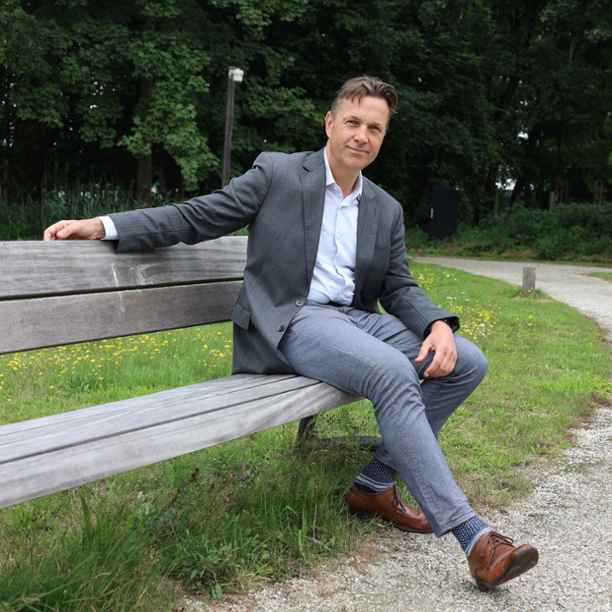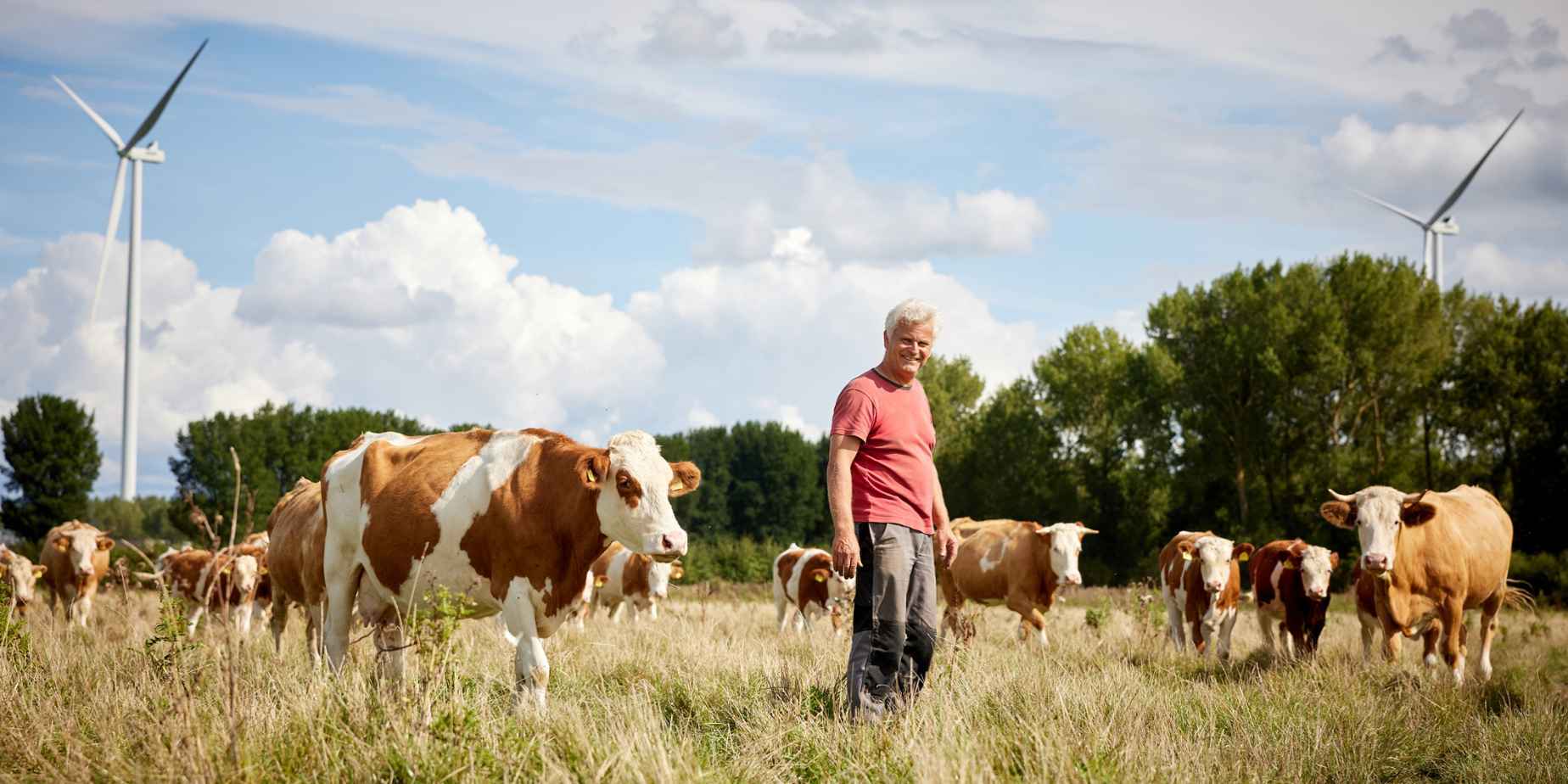If you take the A27 towards het Gooi from Flevopolder, you'll find a new residential area under construction: Almere Oosterwold. This is the newest neighbourhood in the ever-growing city of Almere and a special stretch of area development. Here is the Vliervelden farm, part of Stadsboerderij Almere: a biodynamic farm that grows crops, vegetables, raises cows, and is open to the public. We - photographer and journalist - visited Vliervelden and went in search of the owner, Tom Saat. He started the Stadsboerderij with Tineke van den Berg in 1997. Back then, the farm was situated on the outskirts of Almere, but today it's surrounded by residential areas. Vliervelden is their second farm. The farm has around 200 hectares of land, 180 suckler cows and grows over 20 different types of crops. The farm plays a public role in the community with guided tours for primary school pupils, a farm shop and childcare facilities. Triodos Groenfonds believes the Stadsboerderij is a great example of a business that contributes to a fair, green and social society. It's a business that makes impact as well as returns, but more on that later.
City and countryside: two separate worlds
We find owner Tom Saat on a forklift, busy moving large crates full of white cabbages. Vliervelden includes about 40 hectares of land purchased from the municipality of Almere in 2017. This land can be developed according to their own vision. "Vliervelden is still young," Tom begins, "but the Stadsboerderij has been around since 1997. At the time, the business was located on the border between the city and the countryside. It was a logical place for us because we saw people were becoming more interested in agriculture and food production. But they were really two separate worlds. The name Stadsboerderij reflects that it is our farm, but it’s connected to the city too. This location was also practical for us. If we wanted to sell the meat from our suckler cows, we had to be close to the public. It started with a market stall, then along came the shop and so it rolls on. We can now sell more organic meat than we produce ourselves. The public role we play allows us to make some of the other areas of the business profitable. One fertilises the other.”
Power for the soil
The Stadsboerderij describes itself as biodynamic. Tom explains that this is a step beyond organic farming. The word dynamic comes from the Greek dunamis meaning power. So, you want the farm to produce as much on its own as possible. “Organic farmers don’t use fertiliser, but we do need manure. It gives crops the power they need to grow. That’s the reason we have a mixed farm; the cows are indispensable. We keep them in stalls during the winter. They eat nutrient-rich grass that is home grown, and they produce manure. We mix the manure with straw, which also comes from our farm. This means we can build a substantial compost heap throughout winter and use the resulting manure to enrich the soil. In that sense, it is about farming using its own resources.” Tom points to the hay shed and the feed silos. There are already huge bales of straw and fodder ready for the winter. “All grown ourselves,” he says proudly.
Black gold
We then walk towards the stable. There's not a cow in sight because the animals are all outside in the summer. There's just a row of machines and an enormous pile of manure; the production of one winter. This is what Tom calls 'black gold'. “This manure is what matters most. The soil in the polder is heavy clay, and you want to make it as aerated as possible. With the manure, we give the soil nitrogen, potassium and organic matter. It is the fuel for fertile soil.' Tom climbs on top of the mound and pulls out a big black lump of manure with his hands. 'Here, just smell it. Delicious, isn't it?” And he's right. This is no smelly dung heap; it is reminiscent of fresh forest soil. “Good manure doesn't smell," Tom explains. “This manure is full of nitrogen and carbon. If the nitrogen is fixed, it won't give off the smell of ammonia. This only happens when it meets soil organisms and is released on demand. If everyone worked like this, there would be no nitrogen problem. We’re contributing to the food transition with our way of working.”
Biodiversity
“I believe that biodiversity is a bigger problem than nitrogen,” Tom continues. “Our biodiversity is very high – we have already seen 28 different bee species in our flower and clover fields. This is because we don't use pesticides. Although many still deny it, intensive agriculture causes a decline in biodiversity. So, the system must change, but it’s complicated. In the Netherlands, we have created a farming system that suits current methods. If we want a different system, this will require different qualities. And different people too. I am sometimes caught in the middle. I definitely advocate a different direction, but I also understand the concerns of all those farmers who have been here for
Meanwhile, we walk back to the farm shop where we started. Past the barn, the hay shed, the shop, the feed silos, and all the farmyard developments. Triodos Groenfonds helped Stadsboerderij Almere achieve its vision of biodynamic farming. And Tom and Tineke are not finished yet. They are also looking at how to make their machinery more sustainable, by using hydrogen as fuel, for example. The first tractor is now being converted for hydrogen.
Impact and return
Willy Bulsink, portfolio manager of Triodos Groenfonds, loves Tom's story. For him, Stadsboerderij Almere is a great example of how a business can make its impact transparent. “The Stadsboerderij is a wonderful biodynamic farm, they work with a closed loop, and they look to connect with the local population. These three aspects are very important to us. It’s why we mainly invest in local projects. We take a holistic view, so we want as much agriculture as possible to be sustainable or biodynamic.”
Not every sustainable project is eligible for investment. As a green investment institution, Triodos Groenfonds must comply with the government's Green Projects Scheme. This means that at least 70% of the companies in the fund's portfolio must have a government-issued green certificate. As a green investment institution, investors in the fund may benefit from a tax benefit. “We apply a strict selection criteria. With all our investments, we want to make sure that companies contribute to sustainable development, have no negative impact and achieve a positive return. Because impact is important, but so are returns.”
According to Bulsink, Triodos Groenfonds’ projects show a perfect combination of impact and return. “The impact of our projects can be seen. Look at Stadsboerderij Almere. All the businesses we invest in are doing good. Return and impact go hand in hand. Sustainable businesses demonstrate their concern about tomorrow's risks and challenges through their long-term vision. This is something we see as risk mitigating.”
Article 9
For many private investors, however, it remains a puzzle: what constitutes green and how do I make a real impact? Government regulations should make things easier. Legislation is in place, for example, to ensure that investment institutions do not pretend to be more sustainable than they are. This is known as the Sustainable Finance Disclosure Regulation (SFDR). The aim is to give investors a better understanding of how investment fund managers deal with sustainability. Articles 6, 8 and 9 play an important role in this process, with Article 9 going the furthest (also known as 'dark green').
All Triodos Investment Management investment funds classify as Article 9, i.e. dark green, according to the SFDR framework. “This shows that we go much further than many other funds. Other investment funds often only apply an exclusion list to avoid negative environmental or social impact. We go further. We look explicitly at the positive impact on society and only invest in companies that can make that positive impact.”
The soil is everything
Here at Vliervelden, the cycle may be closed, but the view of the future is wide open. Meanwhile, Tom is already back on the forklift. Those crates of cabbages aren't going to move on their own! But he still has time to make one final plea. “The whole problem culminates in soil fertility. Talking about climate is also related to loss of soil resources. For me, soil is the foundation. After studying soil science, I started as a researcher but eventually wanted to become a farmer. The investment from Triodos Groenfonds has helped create what you see here today. And we’re not finished yet. We’re waiting to see what direction the Netherlands takes. Meanwhile, we’ll continue to build, together with the people around us.”





